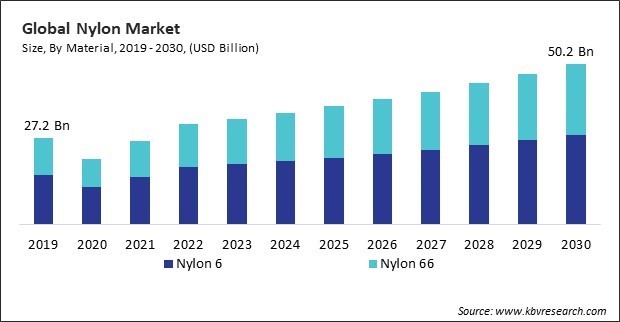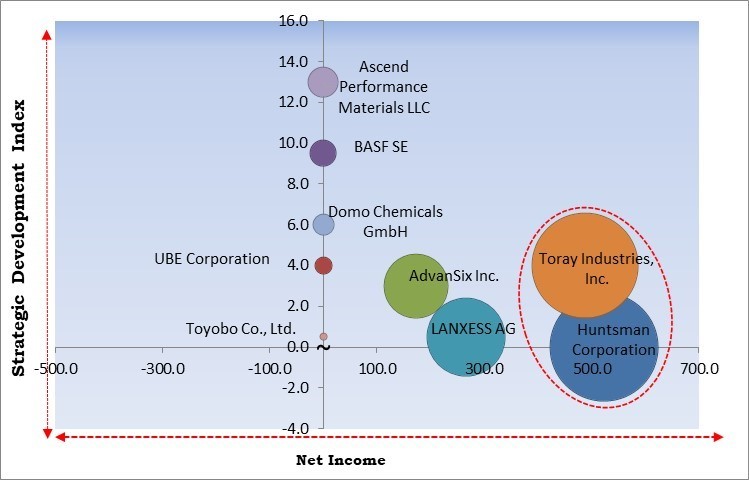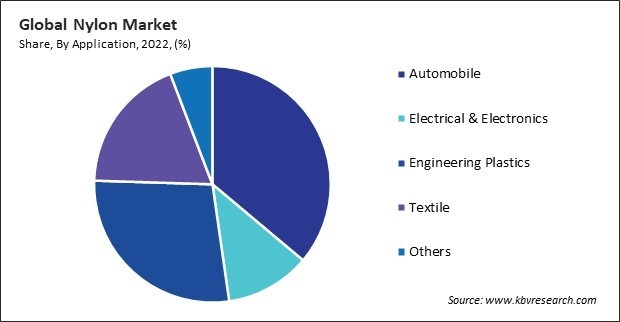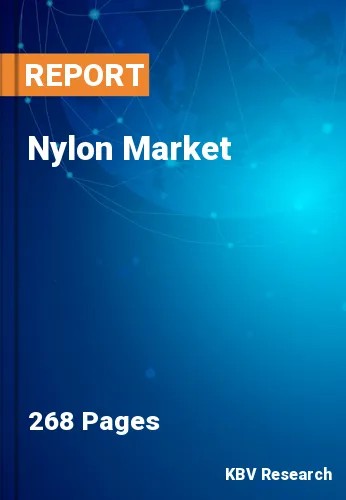“Global Nylon Market to reach a market value of USD 50.2 Billion by 2030 growing at a CAGR of 6.1%”
The Global Nylon Market size is expected to reach $50.2 billion by 2030, rising at a market growth of 6.1% CAGR during the forecast period. In the year 2022, the market attained a volume of 10,239.5 Kilo Tonnes, experiencing a growth of 5.3% (2019-2022).
These fibers can be engineered to be highly elastic and stretchable, allowing for the production of form-fitting and body-contouring garments. Therefore, the textile segment captured $5,878.4 million revenue in the market in 2022. Nylon-spandex blends offer excellent stretch and recovery properties, providing comfort and freedom of movement in tight-fitting apparel such as leggings, swimwear, and shapewear. Therefore, the elasticity of these is driving its growth in the textile industry.

The major strategies followed by the market participants are Product Launches as the key developmental strategy to keep pace with the changing demands of end users. For instance, In June, 2023, Circular Polymers by Ascend Performance Materials LLC launched Cerene, a line of recycled polymers made from proprietary carpet reclaiming technology, available as polyamide 6 and 66, PET, polypropylene, and calcium carbonate. Additionally, In June, 2023, Ascend Performance Materials LLC introduced HiDura LUX amorphous nylon for packaging films in the Asian market, alongside its HiDura PTR puncture and tear-resistant nylon copolymers.
Based on the Analysis presented in the KBV Cardinal matrix; Toray Industries, Inc., Huntsman Corporation are the forerunners in the market. Companies such as BASF SE, Ascend Performance Materials LLC, AdvanSix Inc. are some of the key innovators in the market. In February, 2024, BASF SE has launched Loopamid, a polyamide 6 (PA6, also known as nylon 6), made from 100 percent textile waste, with Inditex, a Spanish multinational clothing company headquartered in Arteixo, Galicia. Through this launch, BASF provided a circular solution for nylon apparel made from textile waste. Zara, by Inditex, made a worldwide jacket with 100% loopamid, using a "design for recycling" approach. All parts, including fabrics, buttons, filling, hook and loop, and zipper, were loopamid-made.

The utilization of engineering plastics, such as polyoxymethylene (POM), polycarbonate, nylon, polyethylene terephthalate (PET), and acrylonitrile butadiene styrene (ABS), presents several benefits in comparison to conventional materials like glass, metals, and ceramics. These plastics are lightweight, corrosion-resistant, and exhibit excellent mechanical properties, making them suitable alternatives for applications where weight reduction, durability, and design flexibility are critical. Furthermore, engineering plastics find widespread use in the automotive industry for interior, exterior, and under-the-hood applications. Components such as bumpers, grilles, interior trim panels, door handles, engine covers, and cooling system parts are often made from engineering plastics due to their impact resistance, design flexibility, and cost-effectiveness. In conclusion, the expanding applications in engineering plastics propel the market’s growth.
Additive manufacturing empowers designers to fabricate intricate structures and complex geometries that are unattainable or impracticable to produce using conventional manufacturing techniques. It’s excellent layer adhesion, thermal stability, and compatibility with additive manufacturing processes such as selective laser sintering (SLS) and fused deposition modeling (FDM) make it an ideal material for producing intricate 3D-printed parts with high precision and accuracy. In addition, iterative design modifications and rapid prototyping are made possible through the use of these additive manufacturing, allowing engineers and designers to rapidly test and refine product designs prior to mass production. Hence, ongoing advancements in additive manufacturing are propelling the market’s growth.
Volatility in raw material prices creates uncertainty for manufacturers and businesses in planning and budgeting. Its production is susceptible to volatile production costs and profit margins due to fluctuations in the costs of key raw materials, including crude oil (for those derived from petroleum) and plant-based feedstocks (for those derived from biomass). Sudden spikes in raw material prices may strain operational budgets and erode profit margins, especially for companies with tight profit margins or long-term contracts. Furthermore, volatility in raw material prices can also contribute to supply chain disruptions. Suppliers may adjust production levels or prioritize customers based on changing market conditions, leading to potential shortages or delays in raw material deliveries. In conclusion, volatility in raw material prices is hampering the market’s growth.
On the basis of application, the market is segmented into automobile, electrical & electronics, engineering plastics, textiles, and others. The automobile segment recorded the largest revenue share in the market in 2022. Using this in the automobile segment helps improve vehicle performance, reliability, safety, and fuel efficiency while reducing weight, cost, and environmental impact. Due to its exceptional adaptability and extensive repertoire of uses, it has become an essential component in contemporary automotive production.

Based on material, the market is bifurcated into nylon 6 and nylon 66. The nylon 66 segment attained a considerable revenue share in the market in 2022. Nylon 66 exhibits better heat resistance, making it suitable for applications that require thermal stability. This product is ideally suited for automobile undercarriage elements, electrical and electronic enclosures, and manufacturing apparatus parts due to its resistance to high temperatures without compromising its mechanical properties.
Free Valuable Insights: Global Nylon Market size to reach USD 50.2 Billion by 2030
Region-wise, the market is analyzed across North America, Europe, Asia Pacific, and LAMEA. The Asia Pacific region witnessed the maximum revenue share in the market in 2022. Asia Pacific countries are major producers and exporters of textiles and apparel, supplying products to both domestic and international markets. These fibers are widely used in textile manufacturing to produce garments, sportswear, activewear, and lingerie due to their durability, moisture-wicking properties, and versatility. The growing consumer demand for fashionable and performance-oriented clothing drives the demand for these textiles in the region.
| Report Attribute | Details |
|---|---|
| Market size value in 2022 | USD 31.4 Billion |
| Market size forecast in 2030 | USD 50.2 Billion |
| Base Year | 2022 |
| Historical Period | 2019 to 2021 |
| Forecast Period | 2023 to 2030 |
| Revenue Growth Rate | CAGR of 6.1% from 2023 to 2030 |
| Quantitative Data | Volume in Kilo Tonnes, Revenue in USD Billion, and CAGR from 2019 to 2030 |
| Number of Pages | 268 |
| Number of Tables | 534 |
| Report coverage | Market Trends, Revenue Estimation and Forecast, Segmentation Analysis, Regional and Country Breakdown, Competitive Landscape, Porter’s 5 Forces Analysis, Company Profiling, Companies Strategic Developments, SWOT Analysis, Winning Imperatives |
| Segments covered | Material, End-use, Region |
| Country scope |
|
| Companies Included | BASF SE, Lanxess AG, Huntsman Corporation, UBE Corporation, Domo Chemicals GmbH, Toray Industries, Inc., Ascend Performance Materials LLC (SK Capital and Partners), Toyobo Co., Ltd., AdvanSix Inc., Goodfellow Cambridge Ltd. (Battery Ventures) |
By Material (Volume, kilo Tonnes, USD Billion, 2019-2030)
By Application (Volume, kilo Tonnes, USD Billion, 2019-2030)
By Geography (Volume, kilo Tonnes, USD Billion, 2019-2030)
This Market size is expected to reach $50.2 billion by 2030.
Expanding applications in engineering plastics are driving the Market in coming years, however, Impact of volatility of raw material prices restraints the growth of the Market.
BASF SE, Lanxess AG, Huntsman Corporation, UBE Corporation, Domo Chemicals GmbH, Toray Industries, Inc., Ascend Performance Materials LLC (SK Capital and Partners), Toyobo Co., Ltd., AdvanSix Inc., Goodfellow Cambridge Ltd. (Battery Ventures)
In the year 2022, the market attained a volume of 10,239.5 Kilo Tonnes, experiencing a growth of 5.3% (2019-2022).
The Nylon 6 segment is generating highest revenue in the Market, By Material in 2022; there by, achieving a market value of $28.1 billion by 2030.
The Asia Pacific region dominated the Market, By Region in 2022, and would continue to be a dominant market till 2030; there by, achieving a market value of $23.3 billion by 2030.
Our team of dedicated experts can provide you with attractive expansion opportunities for your business.

 Drivers
Drivers
 Restraints
Restraints
 Opportunities
Opportunities
 Challenges
Challenges
